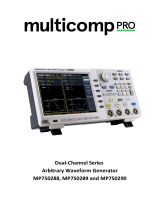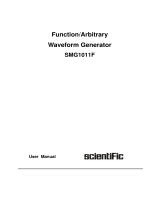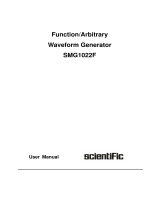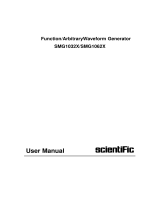
RIGOL
DG1000Z User’s Guide V
Allgemeine Sicherheits Informationen
Überprüfen Sie diefolgenden Sicherheitshinweise
sorgfältigumPersonenschädenoderSchäden am Gerätundan damit verbundenen
weiteren Gerätenzu vermeiden.Zur Vermeidung vonGefahren, nutzen Sie bitte das
Gerät nur so, wiein diesem Handbuchangegeben.
Um Feuer oder Verletzungen zu
vermeiden, verwenden Sie ein
ordnungsgemäßes Netzkabel
Verwenden Sie für dieses Gerät nur das
für ihr Land zugelassene und
genehmigte Netzkabel.
Erden des Gerätes
Das Gerät ist durch den Schutzleiter im
Netzkabel geerdet. Um Gefahren durch
elektrischen Schlag zu vermeiden, ist es
unerlässlich, die Erdung durchzuführen.
Erst dann dürfen weitere Ein- oder
Ausgänge verbunden werden.
Anschluss einesTastkopfes
Die Erdungsklemmen der Sonden
sindauf dem gleichen Spannungspegel
des Instruments geerdet. SchließenSie
die Erdungsklemmen an keine hohe
Spannung an.
Beachten Sie alle Anschlüsse
Zur Vermeidung von Feuer oder
Stromschlag, beachten Sie alle
Bemerkungen und Markierungen auf
dem Instrument. Befolgen Sie die
Bedienungsanleitung für weitere
Informationen, bevor Sie weitere
Anschlüsse an das Instrument legen.
Verwenden Sie einen geeigneten
Überspannungsschutz
Stellen Sie sicher, daß keinerlei
Überspannung (wie z.B. durch Gewitter
verursacht) das Gerät erreichen kann.
Andernfallsbestehtfür den Anwender
die GefahreinesStromschlages.
Nicht ohne Abdeckung einschalten
Betreiben Sie das Gerät nicht mit
entfernten Gehäuse-Abdeckungen.
Betreiben Sie das Gerät nicht
geöffnet
Der Betrieb mit offenen oder entfernten
Gehäuseteilen ist nicht zulässig. Nichts
in entsprechende Öffnungen stecken
(Lüfter z.B.)
Passende Sicherung verwenden
Setzen Sie nur die
spezifikationsgemäßen Sicherungen
ein.
Vermeiden Sie ungeschützte
Verbindungen
Berühren Sie keine unisolierten
Verbindungen oder Baugruppen,
während das Gerät in Betrieb ist.
Betreiben Sie das Gerät nicht im
Fehlerfall
Wenn Sie am Gerät einen Defekt
vermuten, sorgen Sie dafür, bevor Sie
das Gerät wieder betreiben, dass eine
Untersuchung durch qualifiziertes
Kundendienstpersonal durchgeführt
wird.Jedwede Wartung, Einstellarbeiten
oder Austausch von Teilen am Gerät,
sowie am Zubehör dürfen nur von
RIGOL autorisiertem Personal
durchgeführt werden.
























